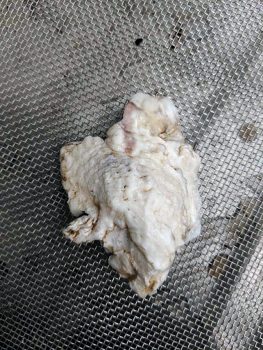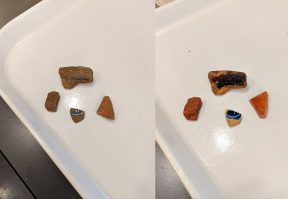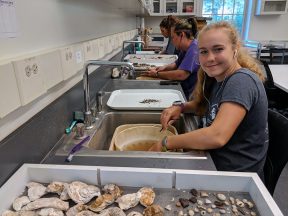Back to Dispatches from Field School
Field School 2019 – Week 4, Part 2
James Jackson — St. Mary’s College of Maryland
“Washing Artifacts, Exams, and the Time Team”
The fourth week started with the whole team reconvening at the dig site. Last week, three of us had been sent to the lab to learn how to clean artifacts, and tomorrow three more would be sent to take their place. I would be one of them. Until then, however, we dug! As two of our original units were close to being finished, we opened up two more. We used a total station to find opening elevations, and then measured out and strung up two new five by five squares to dig in. By the end of the day, we had taken all of the sod off the top of the units and were very ready to go home. The weather had been hot, humid, and sunny, and though we started the day out laughing and joking, the day ended mostly in silence as we collectively tried not to overheat.

Oysters that grow to the surface develop a rough shell and purple ‘scars’, which tell us that they were likely harvested on a shallow beach.
On Tuesday morning, I met at the lab at 9:00am along with two of the other field school students to begin cleaning artifacts. First, we learned the basic procedures—how to clean different kinds of artifacts and how to sort and re-bag the artifacts for future analysis. Because the lab had yet to receive any of the recently uncovered material, we spent most of the day cleaning oyster shell that had been recovered in the 1990s.
Why do we clean oyster shell? Well, the ones we had found were thousands of years old, having been eaten by Native Americans. Cleaning and conserving the shells allow us to study how and what the Native Americans ate: Did they cook the oysters? How did they cook them? What kind of oysters did they usually try to eat? The shells could have burn marks on them, or maybe even damage from tools used to collect them. It may not be as glamorous as washing an ornate piece of ancient pottery, but here at St. Mary’s, we value every artifact equally.
Wednesday was actually our exam date! For the exam, we were led into the Study Collection room. In there, we were greeted with tables full of numbered artifacts and our exam sheets. Based on conversations with other students after the exam, we all seemed pretty happy with our results though, as always, there were a number of hindsight realizations. The afternoon was spent listening to a lecture and watching an episode of the British archaeological show, Time Team! The lecture was about the people who worked at Historic St. Mary’s, what they did, and where they eventually wound up working, while the episode was actually about the Time Team visiting in the late 90s. They helped to uncover a lost site, as well as try and narrow down the elusive St. Mary’s Fort which we have still not been able to find. The episode, sadly, was wrong about its location.

After cleaning, it’s easier to identify the artifacts. In this case, we can tell that once of these ceramics is, in fact, a sneaky piece of brick!
On Thursday we finally began to clean some of the artifacts we recovered in the previous week. In addition to more oyster shell, we cleaned brick, ceramic, glass, iron, and some special artifacts such as lead shot and bone! It is imperative that we get as much dirt as possible off of each artifact. Mostly, this is because it helps to identify the artifact. What may have been put in with the brick could reveal to be the red paste from someone’s old storage jar! It also removes material that may be harmful to the artifact, as well as get it ready for the conservators to fully clean and preserve.
Finally, on Friday finished with the work started the day before, cleaning up the last of the brick and sorting things out to dry before the next set of students come to work on Tuesday. After a week of spending all day indoors, we were very excited to get back to work in the field. As nice as it was to be in the air conditioning all week, especially considering the high temperatures, we really missed digging in the field with the rest of our staff.


